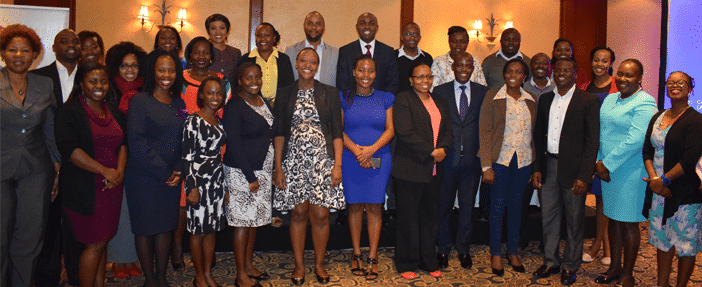Table of Contents
The 4th edition of the quarterly HR forum
The 4th edition of the Brighter Monday HR Forum, was recently held on the 29th of June at the Fairmont Norfolk Hotel and as usual, the sessions were illuminating, interactive, and most of all, exciting. This time round, the discussion was all about rightsizing, where adept HR practitioners and legal professionals took the attendees through the ropes on rightsizing and downsizing.
The keynote speakers gave great insights into the role of the HR in ensuring that rightsizing and downsizing are done right. The main themes of the discussions were:
- Continuous rightsizing practice
- Rightsizing: The legal aspects
- Redundancy
Continuous Rightsizing by Denis Nyongesa, HR Director, Ramco

The first session was by Denis Nyongesa, an experienced HR practitioner in the manufacturing sector. Mr Nyongesa took the attendees through the ropes on right sizing, which he described as a continuous process of reorganising jobs and human resources, to meet the changing needs of the organisation. He highlighted the following salient points in the process of rightsizing:
- Annual manpower planning is critical as it forms the basis on which decisions of hiring or reduction of job roles are based
- It is based on annual strategy of the company cascaded to the department
- Jobs are described to fulfil the needs foreseen
- Some jobs may be scrapped or created due to change in strategy for the year.
- Employees are supported through training to take up multiple roles
For rightsizing to be effective, it is important to realise that it is a continuous process which involves:
- Periodic job evaluations
- Conducting regular job profile audits
- Conducting periodic job analysis
From Mr Nyongesa’s presentation, it emerged that right-sizing should be a continuous process and not a project. He presented it as a process of constantly reorganising the organisation’s human resources to meet the changing needs of the organisation. However, sometimes rightsizing takes place as a project, in the form of downsizing.
Redundancy by Eric Kariuki, A Senior Consultant at Richemele International

Having established that sometimes, rightsizing involves downsizing, the next speaker was a skilful talent planning, organisational design, resourcing and employee management HR practitioner who took the attendees through the process of downsizing. According to Mr Kariuki, redundancy has 3 main characteristics:
- It targets jobs
- It is caused by restructuring and insolvency
- The reason for restructuring or insolvency may be technological, economic or operational
When carrying out redundancy, it is important to follow the following steps to make the process as smooth as possible:
- Communicate with the entire organisation on the reason for the redundancies, the process and proposed timelines, and the available support to those who will be affected
- Consult widely and notify all the employees, the affected employees, and third parties such as labour unions, labour officials, and lawyers where necessary
- Review and prepare employee file, policies and legal provisions, termination documents, and communique
- Process and execute notifications, termination letters, handover process, and terminal dues
- Support the redundant employees through assisted job search, and referrals
Before declaring an employee redundant, it is important to consider the following options;
- Redeployment
- Secondment
- Rehiring
- Job enlargement
- retirement
Rightsizing: The Legal Aspects by Jacob Ochieng’, a partner at Oraro & Co. Advocates

Next on stage was an accomplished advocate who gave the HRs in attendance the legal frameworks in downsizing. Declaring employees redundant is a legal process and if not done right, it could lead to serious legal problems for employers. According to Mr Ochieng, the legal framework governing redundancy is covered by:
- The Kenyan Constitution, 2010
- The labour relations act, 2007
- The employment act, 2007
- ILO conventions
- Case law
The redundancy process is covered by section 40 of the employment act and it is very particular about:
- The process of giving notices
- The selection criteria for the employees to be declared redundant
- The redundancy benefits that the employees should enjoy
An Insight into Technology and HR Solutions by Joseph Mathenge, Chief Information Security Officer at Airtel Africa

The final presentation was by Joseph Mathenge, an accomplished systems analytics practitioner who gave insights into how technology affects and assists HR. His main points were:
- During redundancy, those affected should be given sufficient notice and in the course of the week so as to reduce chances of them leaving with data
- HR should coordinate activities well with the systems administrator to ensure that the necessary rights of access to information are revoked on time
- Data security should always be a priority to avoid compromising the company
- All computers used on the system ought to be closely monitored to avoid having cases where data is illegally shared or used, thus, personal computers should not be used for work and outside work
Panel Session

At the end of the session, a panel consisting of the 4 keynote speakers and Judith from Oraro & Co advocates handled questions from the attendees. It emerged that the process of rightsizing and downsizing is often challenging and there needs to be more information on the best practices.
It was a very engaging session and the attendees gained a lot of information. Additionally, the HR practitioners in attendance gained 1 CPD point, which is definitely a boost in their careers.
Here is a Pictorial summary of the HR Forum.


We hope to see you in the next forum.





